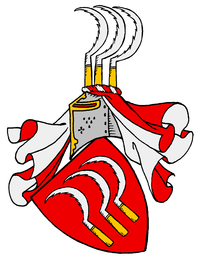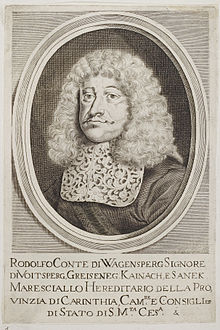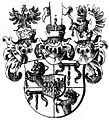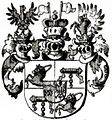Wagensperg wagon

Wagen von Wagensperg is the name of a very old noble family . As the first of the family in the Duchy of Carinthia to appear in a documented 1394 Christoph and 1426 Balthasar Wagen . An uninterrupted line of trunks began with Balthasar Wagen (documented) 1462–1471. The wagons were knights , clergymen, imperial councilors and distinguished themselves several times in armed conflicts. Some were ardent supporters of Protestantism . Several of them were to be found at various universities of the time. The predicate Wagensperg comes from Wagensberg Castle, Slovenian grade Bogenšperk, located in Carniola , then part of Carinthia, not far from Litija (once Littai) on the Save (Slov. Sava).
history
origin
Kneschke and Schumi claim that the cars are descendants of a ministerial family Vagn, also Vagen, from the Rosenheim area in Upper Bavaria . A Berthold Vagen is said to appear in a document from 1190 by the Bishop of Freising, an Ottonian. In documents of the Diocese of Freising from the years 1230–1252 a Heinrich de Vagn, de Vagen, also Vagenarius is mentioned, a Freising Ministeriale from the area of Miesbach in Bavaria. In a directory of the Freising Bishop Konrad III. even an ulricus de Wagensperch appears.
Presumably the wagons came to Carniola from Carinthia or southern Styria in the middle of the 15th century . The first documented car in Krain was Balthasar Wagen. He appears in one of the Emperor Friedrich III. privilege issued on January 12, 1463 . There he is listed among the Carniolan knights who a year earlier hurried to the aid of the emperor in Vienna , where he was trapped and besieged by Duke Albrecht . In gratitude for this, the emperor improved the coat of arms of Carniola.
possession
In addition to their property in Krain, the Wagensperk were also wealthy in Carinthia and southern Styria.
In 1466, Balthasar and his brother Andree received the Grafenwarth / Kostel rule on the Kolpa from the emperor as a pledge against payment of 700 Hungarian ducats. Balthasar was at that time the imperial Vogt on Hasberg (Slov. Planina pri Rakeku) and Steinberg bei Zirknitz (Slov. Šteberk pri Cerknici).
When the inheritance was divided in 1471, Andree received all the goods in southern Styria. Balthasar, who with Veronika, the daughter and sole heir of Balthasar v. Liechtenberg - the Liechtenberg was a long-established family in Krain - was married but stayed there.
Dominions in Carniola that were temporarily owned by Wagensperg - (after Majda Smole)
- Gschieß - Selo pri Šmartnem
- Hagenegkh (no Slovak name known)
- Country road - Kostanjevica na Krki
- Liechtenberg - Lihtenberk pri Bogenšperku
- Littei - Litija
- Podwein - Podvin
- Poganik - Poganek
- Ponowitsch - Ponoviče
- Regwergschüß (no slow, name known)
- Schwarzenbach - Črni potok
- Wagensperg - Bogenšperk
Genealogy (incomplete)
Jobst Wagen, * / †, appears in 1412 in Gurk's registers in Carinthia. ⚭ with Kunigunde v. Globasnitz , Td Konrad v. G., administrator of the Gurker office in Weitenstein / Vitanje. Around 1442 she and her grandchildren were still alive.
Son: Friedrich , † before 1442
- Children (of Friedrich, as far as known):
- 1. Balthasar I. Wagen, * / † around 1487 or before, Ritter, urk. 1462/63. He was among the knights who in 1462 emperor Friedrich III. came to Vienna to help. In 1466 he and his brother Andree received the rule of Grafenwarth (Kostel) in the Dürrenmark (Krain) from the emperor as a pledge for 700 Hungarian ducats. 1465/1477 Imperial bailiff on Hasberg / Hosberg near Alben / Planina and on Schneeberg (Slov. Snežnik), ⚭ around 1470 Veronika von Liechtenberg , heiress of Balthasar v. L.
- Children (of Balthasar, as far as known):
- 1) Berthold, * / † 1477,
- 2) Erasm , * / † Wagensperg (?) March 16, 1522, ( he follows )
- 2. Andree, * / †; 1474-1490 he was administrator of the salt pans in Aussee . His economic focus was in southern Styria (Weitenstein - Vitanje, - Jamnik, Schönstein - Šoštanj). Probably no descendants, because his great-nephew Hans Wagen († 1553) inherited his property in southern Styria.
- 3. Wilhelm, † before 1471
Erasm , * / † Wagensperg (?) March 16, 1522, buried in the church of St. Martin near Littei (Slov. Šmartno pri Litiji), where a grave slab can still be seen with the inscription: HIE LEIT BURIED / DER EDEL VND VEST ERASEM OF THE DIED / DID IN M CCCC XX II OF DAY 15 MERZ. He is also said to have been the builder of Wagensperg Castle (1522). ⚭ Agnes v. Apfaltrer , T. d. NN Apfaltrer.
- Children (of Erasm, if known)
- 1. Hans , * / † April 15, 1553, his tombstone can be found in the church of MB zu Wöllan / Velenje with the inscription:
- HIE LIGT BURIED THE / R EDL VND FEST HER HANS WAGEN ZV WAGENSPERG / DIE DAY 15 / DAY OF APRILIS IN 1553 / IAR DEM GOT GRADIG / VND MERCY / SEIN WEL AMEN.
- Around 1544 he called himself Hans Wagen zu Wagensperg. He was the founder of the Styrian line of wagons. ⚭ Helene v. Petschacher , Td Felizian v. P. ud Magdalena vd Dörr .
- Children (of Hans, if known)
- 1) Balthasar II., * / †, ⚭ Katharina Schratt zu Kindberg , (at least 8 sons came from this connection), Td Siegmund v. Sch. ud Juliana v. Lamberg ,
- Children (of Balthasar II as far as known)
- (1) Hans Sigismund, he held high offices, in 1602 raised to the baron class, 1621 appointed Oberlandmarschall von Kärnten, 1625 count class. The last of these counts died on January 8, 1924 in Seltenheim Castle near Klagenfurt.
- (2) Juliana, ⚭ Erasm v. Dietrichstein , Sd Siegfried v. D. ud Ursula v. Siegersdorf ,
- 2) NN
- 3) NN
- 4) NN
- 2. Christoph I * / † around 1586, ⚭ Veronika v. Gall zum St. Georgenberg , Td NN Gall, from this connection should have 12 sons and 8 daughters. A visitation report from 1585 is said to show that he was an ardent Lutheran. In 1569 he bought half of the Wagensperg estate from his nephew Balthasar von Wagen, making him the sole owner of the estate. His sons were heirs in equal parts.
- Children (of Christopher I, as far as known)
- 1) Constantine, * / † mid-1595; he bears the title "Wagen von Wagensperg zu Podwein". ⚭ November 29, 1587 Sibylle Sauer zum Kosiek
- Children (of Constantine, as far as known)
- (1) Hans Daniel, * / † before June 23, 1649; 1621 raised to the baron class;
- Children (of Hans Daniel, as far as known)
- a. Sigismund Ehrenreich, * / † 1685; he carries the title “Wagen von Wagensperg zu Podwein und Sagoritz”, ⚭ Justina Eleonora von Bucelleni , Td NN v. B .;
- Children (of Sigismund E., if known)
- a) Hans Andreas, * / † 1718 (according to others 1707) he appears as the owner of Podwein, which he gave to Hans Daniel Freiherrn v. Gallenfels sold. On behalf of his underage heirs, Johann Baptist Weinizer sold the rule to Johann Daniel Freiherren von Gallenfels in 1721.
- 2) Georg, * / † Augustinian monastery in Laibach, June 1630; 1581 student in Rostock , 1582 in Wittenberg ; Back in Carniola in 1591, he sold two archespergian farms to the Lanthieri brothers. In 1586 and 1593 he received the same share of the inheritance as his other brothers. In 1610 he inherited several farms from his brother Constantine. 1621 Elevation to the baron class. In that year he inherited the entire property of his brother Christoph II and became the sole owner of Wagensperg. He left Krain again for a long time. In 1623 he received the Carinthian Inkolat . In the same year all the goods of his late brother Adam fell to him. Back in Carniola in 1627, where he soon became a Terziar in the Augustinian monastery in Laibach. He also made the order an heir, even with papal approval. But because of his high debt, everything fell to his creditor, the mayor of Laibach and pharmacist Horatius Carminelli. The Augustinians then sent the invoice for Georg's funeral to his nephew Hans Daniel von Wagensperg.
- 3) Franz, * / † before 1619, he carries the title "Wagen von Wagensperg zu Poganik"; He bought Littei (Litija) in 1583 from the minor heirs of Sigmund v. Gallenberg , the ward of Georg v. Rain and Hans v. Gallenberg. On April 20, 1587 he exchanged Littei with Georg Balthasar v. Wernegkh versus Poganik. ⚭ Ottilie Nikolich , Td NN. Nikolich; In 1631 she sold the entire property to Michael Friedrich Hüller.
- 4) Christoph II. * / † around 1621; Corresponding correspondence with the Carniolan Fief Commission shows that he finally lived alone on Wagensperg and that the whereabouts of his brothers were unknown. In 1606 he bought the Schwarzenbach / Črni potok estate from Ehrenreich Peltzhofer , which he sold again in 1612. Around 1613 he owned the Wagensperg estate with his brother Georg.
- 5) Adam, * / † 1619-1627; he seems to have sold his inheritance. From his surviving diary from the years 1591–1592 it can be seen that he studied in Jena in 1591 and stayed in Leipzig, Prague in 1592 and in Padua in the autumn. In the years 1606-1609 he lived with his brother on Poganik. In 1614 he bought the Ponowitsch estate from the heirs of Wilhelm Praunsperger from Laibach. He died with no offspring.
- 6) daughter NN, * / †; ⚭ Ehrenreich (?) Peltzhofer
Important namesake
- Franz Anton Adolph von Wagensperg (* 1675; † 1723), 1702–1712 Prince-Bishop of Seckau and 1712–1723 Prince-Bishop of Chiemsee
- Rudolf Wagen Graf von Wagensperg , Lord of Sonegg (Saneck), Voitsberg, Kainach and Greisseneck († 1679), Colonel Hereditary Land Marshal and inheritance in Carinthia, Imperial Privy Council
Ennobling
Baron class
- 1559
- 1602 for Hans Sigismund Wagen. Since then, the family carried the name Wagen von Wagensperg .
- 1619 for his brothers
- 1621 for the brothers Georg and Hans Daniel Wagen
- 1622 additional title Mr. von Sonegg
Count estate
- 1625 for Hans Sigmund, with the title Herr auf Sonegg, Voitsberg and Greisseneck
- 1659
Others
1619 Appointment as Colonel Hereditary Land Marshal of Carinthia.
In the Estates Nobility Register of Krain, the family is still listed under the name Wagen.
coat of arms
Family coat of arms
Blazon : The family coat of arms shows the shield in red with three right-facing silver sickles with golden stems standing side by side ; the three sickles on the helmet with red and silver covers .
Alliance coat of arms
Blazon: The alliance coat of arms of the wagons with those of Liechtenberg ( coat of arms 1463) shows the family coat of arms at the front, a red crowned and gold- armored eagle on a green three-mountain in the rear in a silver field .
Alliance coat of arms of the Knights of Carriage and Liechtenberg, after Zacharias Bartsch (1567)
Count's coat of arms
Blazon of the Count's coat of arms: shield divided lengthways; on the right in red three side by side, with the serrated sharpness turned to the right, provided with golden handles; left in silver, a red, gold-crowned eagle (Liechtenberg). Two crowned helmets stand over the count's crown , the right one carrying the three sickles of the right half of the shield, the left the eagle of the left half of the shield. The helmet covers are red and silver. This is the reproduction of the coat of arms of the Austrian monarchy (VIII, 37), but there are other, different versions.
The Roman-German king and later Emperor Ferdinand I in 1546 gave the brothers Hans and Christoph for their bravery in fighting the Turks and because Hans in his younger years Page his wife Anna was in the yard and later the post of silver chamberlain held, also the coat of arms of the Liechtenberg, after with Franz v. Liechtenberg the sex was extinct.
literature
- Joannes Franciscus Buddeus : General historical Lexicon , Volume 4, Verlag Thomas Fritsch, Leipzig 1722, p. 698 .
- Constantin von Wurzbach : Wagensperg, the counts of, genealogy . In: Biographisches Lexikon des Kaiserthums Oesterreich . 52nd part. Imperial-Royal Court and State Printing House, Vienna 1885, p. 74 f. ( Digitized version ).
- Constantin von Wurzbach : Wagensperg, the counts of, coat of arms . In: Biographisches Lexikon des Kaiserthums Oesterreich . 52nd part. Kaiserlich-Königliche Hof- und Staatsdruckerei, Vienna 1885, p. 79 ( digitized version ).
- Branko Reisp: Bogenšperk, Kulturni in naravni spomeniki Slovenije , Zbirka vodnikov No. 70 (Bogenšperk, Cultural and Natural Monuments of Slovenia, Guide Collection) Ljubljana 1976.
- Branko Reisp: Valvasorjev Bogenšperk (Valvasors Bogenšperk), Ljubljana 1982.
- Majda Smole: Graščine na nekdanjem Kranjskem ( Lords of the former Carniola), Ljubljana 1982.
- Genealogical manual of the nobility , ( Adelslexikon ) , Volume XV / 2004.





